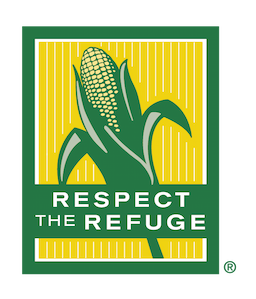Fighting Glyphosate-Resistant Marestail? Get the Facts
September 6, 2021
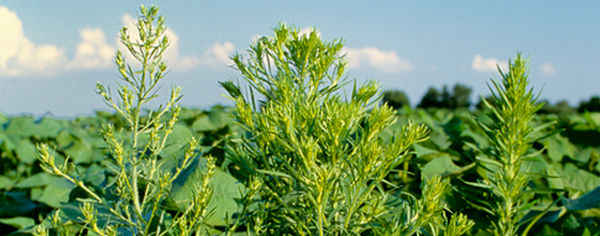
The odds are that most growers today are fighting glyphosate-resistant marestail in their row crops. Become familiar with marestail, which produces high seed counts, grows quickly and tall and produces multiple flushes throughout the growing season.
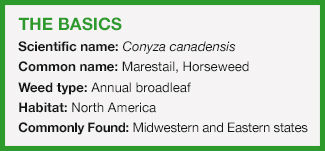
Prolific Seeds, Drought Hardy
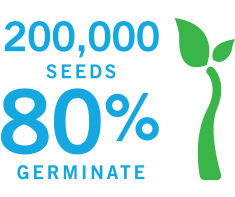
The huge numbers of seed produced by marestail – up to 200,000 per plant – can blow into fields for miles around. Up to 80 percent can germinate immediately.1 Marestail seeds usually do not survive very long in the soil, but seedlings can: Up to 90 percent of fall-emerged marestail seedlings can survive winter as rosettes and bolt in spring.
Marestail is also drought hardy, thriving and shedding seed while crops suffer stress.
A few plants allowed to go to seed in one growing season can infest entire fileds in just a couple of years.
Multiple Life Cycles Threaten Crops:
With both a winter and a spring/summerlifecycle, marestail has a huge opportunity to go to seed and rob crops of sunlight, nutrients and yields. Zero tolerance, then, should be the goal. Just a few plants allowed to go to seed in one growing season can infest entire fields in just a couple of years.
Winter Life Cycle:
Marestail germinates in the fall. It then overwinters in the low-growing rosette stage, where it remains through late April. The plant then bolts, growing 3 to 6 feet if not controlled.
Spring/Summer Life Cycle:
Marestail will follow a similar growth pattern but can emerge as late as early summer.2 The weed can also host insects such as leaf hoppers and diseases such as yellow aster.
Identifying Marestail
The ridged plant stem is covered with long white hairs. Plants have a columnar appearance, with narrow leaves about 3 to 4 inches long alternating around the stem. Tiny, daisy-like white and yellow flowers grow near the top of the plant from midsummer to fall.
Known Resistance in Marestail
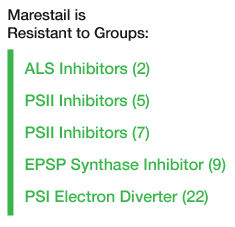
According to some experts, most marestail populations are now resistant to glyphosate (9), and approximately 25 percent of populations are resistant to ALS-inhibiting herbicides.2 In fact, several Midwestern states report that glyphosate-resistant marestail is one of the top three problematic weeds, along with waterhemp and Palmer amaranth. The use of best management practices can keep these resistant weeds from going to seed and entering the soil seedbank.
How Do I Manage Marestail?
The two main ways to manage marestail include tillage and herbicide treatments.
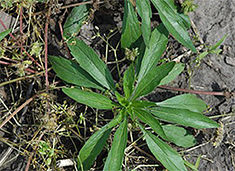
Tillage:
Because marestail seeds only germinate on or near the soil surface, reduced- and conservation-tillage systems have helped marestail become a major weed problem.
Near planting time, tillage that thoroughly mixes the upper few inches of soil and uproots existing plants will remove marestail between the rows.
Rotate crops and use tillage when necessary, especially to reduce heavy marestail infestations.
Herbicide:
Marestail is most susceptible to herbicide control while young. Bayer recommends targeting weeds before they reach 3 inches tall.
University researchers recommend the following herbicide strategy to manage marestail:2
- In corn fields with a history of marestail problems, spray in the fall if you see marestail seedlings. Warning: Failure to treat marestail-infested fields in the fall can result in overwintered marestail the following spring.
- Apply burndown and residual herbicides near planting to ensure that give your field a clean start.
- During the spring, watch for early-emerging marestail and control rosettes before they bolt. This will ensure effective burndown.
Spring-germinating marestail can emerge as late as early summer, so a comprehensive herbicide strategy including multiples classes of chemistry will provide the most effective control and long-term reduction.2 Post-emergence treatments can help manage weed seed production and multiple weed flushes.
Controlling Marestail in Corn
Bayer has a broad portfolio to combat tough-to-control and resistant marestail.
Bayer offers corn growers season-long weed control options, starting with Corvus®, pre-emergence herbicide. Corvus provides burndown to take out early weeds, and residual that reactivates with just a half inch of rain to protect crops for several weeks after application.
Bayer also offers DiFlexx®DUO, a powerful, post-emergence herbicide that helps fight against the toughest weeds, including glyphosate-resistant marestail, by using two sites of action (SOAs) to help manage resistance. DiFlexx Duo also works with Corvus as part of a zero-tolerance weed management program. This effective, two-pass program helps stamp out weeds early, and keep crops safe all season long.
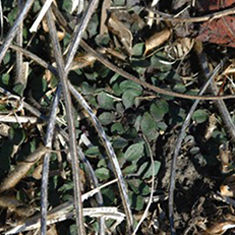
Learn more about how to use Corvus and DiFlexx Duo to fight back against marestail and increase yield potentials as part of a Zero-Tolerance approach to weed management.
The two most important considerations in any well-thought-out herbicide program are herbicide sites of action and the weeds you want to control. Remember: Not every product is suitable for every situation nor registered in every state, and proper application techniques will enhance results. Before applying any herbicide, please read the entire label for the best possible results and to confirm that the product is effective on the weeds you wish to control. Corvus is a Restricted Use Pesticide.
Consult with your local Bayer representative for specific marestail recommendations.
© 2018 Bayer CropScience LP, 800 North Lindbergh Blvd., St. Louis, MO 63167. Always read and follow label instructions. Bayer, the Bayer Cross, Aeris, Velum Total, Baythroid XL and Leverage 360 are registered trademarks of Bayer. Aeris, Baythroid XL and Leverage 360 are Restricted Use Pesticides. Not all products are registered for use in all states. For additional product information, call toll-free 1-866-99-BAYER (1-866-992-2937) or visit our website at www.CropScience.Bayer.us.
Sources:
1. Sarangi, Debalin. "When is a Good Time to Scout and Control Glyphosate-Resistant Marestail?" March 2017. https://cropwatch.unl.edu/2017/when-good-time-scout-and-control-glyphosate-resistant-marestail
2. Loux, Mark. "Strategies for spring marestail management." Feb. 2012.





